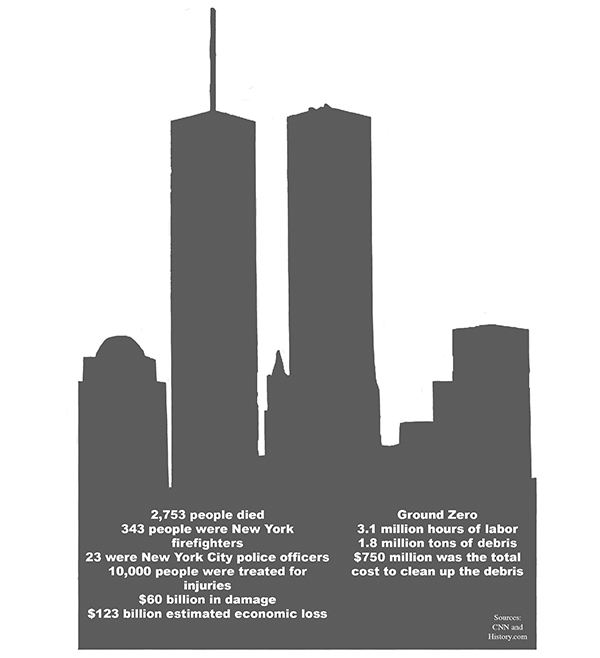By DR. KAYLENE ARMSTRONG, News Adviser

My journalism class was silent as we watched the television in our classroom in disbelief — the Twin Towers in New York were on fire after being struck by two planes hijacked by terrorists.
The division chair of the college where I taught in northeast Ohio at the time had caught me only minutes earlier on my way to my 9:30 a.m. class that Tuesday. I hadn’t watched or heard any news yet, so I didn’t know the terrorist attacks had occurred.
“You’ll want to turn on the TV,” he advised. “Great example of breaking news.”
When The Towers Collapsed
I had turned off the lights in the classroom for better viewing, intending that my Journalism 1 class would watch this breaking news event for a few minutes and then return to a regular class discussion.
That never happened.
The entire class period, we all sat and watched wordlessly as New York City, about an 8-hour drive east of us, mobilized to deal with the disaster that killed almost 3,000 people.
When the South Tower collapsed at 9:59 a.m., many in the room gasped. One student, Paula Kimmich, came to my side and asked to speak to me in the hall.
She was fighting tears.
“My sister works in the Twin Towers,” she explained. “I have to go. I don’t know when I’ll be back.”
I asked her to do one thing for me: “You HAVE to write about this experience when you get back.”
She was shocked that I would suggest such a thing but agreed to think about it.
The people affected
Paula did write that story a few weeks later, a story of one of the miracles of 9/11.
Here’s what happened in a nutshell:
After she left campus, Paula and her brother drove to New York, arriving in the wee hours of Sept. 12. Friends helped them get into the city because many roads and bridges were closed. They had been unable to contact their sister by phone before arriving and now searched her apartment for anything that might help them find her.
They did what everyone trying to find loved ones was doing: attended vigils in the street, scoured signs near the Twin Towers where people posted pictures and information about the dead or missing, wandered the streets looking for guidance about what to do next.
Finally, they decided if their sister was still alive, she was probably hurt, so they split up the list of hospitals in the city and went looking for her. She wasn’t at any of them.
They branched out into northern New Jersey, going to every hospital that had taken in the wounded. At one hospital, they were told no one by that name had been admitted, but the hospital did have an unidentified woman whose face was badly swollen and eyes bandaged because of injuries from glass and debris. She would likely be unidentifiable.
Besides, she was heavily medicated and could not talk.
Still, Paula and her brother asked to see the woman and immediately recognized she was their sister from a ring she was wearing.
The tale made a terrific story that ran in the student newspaper on Oct. 3. The local daily newspaper asked to run it, and Associated Press picked it up as well.
Paula Kimmich was not my only connection to the tragedy we now call 9/11. Another student lost an aunt when the third plane slammed into the Pentagon in Washington, D.C.
Several people I knew both off and on campus had friends and family in New York, either living or visiting there at the time. Many of those people made their way down to the Twin Towers area immediately after the attacks and reported back on the horrors they saw there.
The 9/11 connection
In a way, all of us at the college in Ohio felt connected to the terrorist attack. It seemed everyone knew someone with a connection to New York that day.
And we all felt a need to do something. That Friday, many of the students (the campus had 8,000 at the time), faculty and staff crammed into an open area of the student center for a prayer service. People reported all-time high attendance at church services all over the area for the next several Sundays.
In mid-March of the following year, I attended a college journalism conference in New York City. A fellow newspaper adviser and I visited the viewing stand set up near the Twin Towers site. It was six months since 9/11, but workmen were still clearing the rubble — even at 9:30 p.m. when we stopped by.
The crowd on the stand was solemn, almost reverent. Two spotlights pointed skyward, a reminder of the two buildings that were now just debris. As we stood there watching the workers, we heard a shout and the work stopped.
Men crowded around a small area, examining something we could not see. We wondered if they had found another body or part of one. We each said a silent prayer.
Then our allotted time on the viewing stand was over, and we had to leave.
As we headed back to our hotel, we felt as if we needed to whisper in this place where thousands lost their lives.
And then we cried for the losses — and the miracles — from 9/11.
